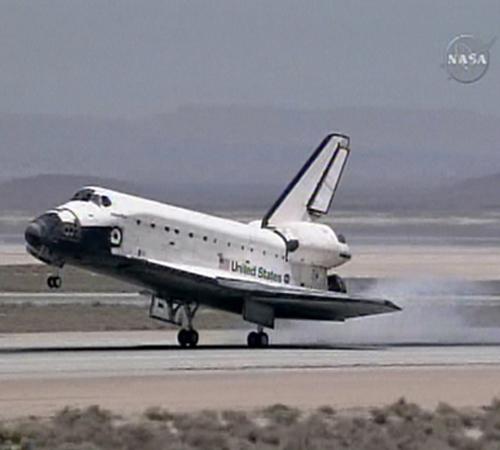Atlantis returns to Earth after 2-week mission to international space station

In this image from NASA TV, Space Shuttle Atlantis lands at Edwards Air Force Base, Calif., Friday, June 22, 2007. The Associated Press
June 22, 2007
EDWARDS AIR FORCE BASE, Calif. – Atlantis and its seven astronauts returned to Earth safely Friday, ending a two-week mission to deliver an addition to the international space station and bring a crew member home from the outpost.
Atlantis crossed the Pacific and glided to a stop at 12:49 p.m. on a runway at Edwards Air Force Base in California. NASA managers had hoped to land the shuttle in Florida, but bad weather forced them to abandon that plan.
“Welcome back,” Mission Control told Atlantis. “Congratulations on a great mission.” Controllers praised the crew for providing a “stepping stone to the rest of NASA’s exploration plan.”
Atlantis’ return from NASA’s first manned flight of the year was marked by its trademark twin sonic booms that were heard from San Diego to Los Angeles. After deploying its parachute, the shuttle came to rest on the concrete runway under mostly sunny skies.
Astronaut Sunita “Suni” Williams returned to Earth on Atlantis after spending more than six months at the space station. She set an endurance record for the longest single spaceflight by a woman at 195 days. During her stay, she also set the record for most time spacewalking by a woman.
Get The Daily Illini in your inbox!
She told reporters two days before landing that she looked forward to a slice of pizza and walking on the beach with her husband and dog, Gorby. But she was going to miss the space station.
“When you’ve been somewhere for six months, it becomes your home and it’s hard to leave,” Williams said.
Shortly after landing, ground crews checked the spacecraft to ensure it was free of toxic gases. The astronauts were given the green light to change out of their orange spacesuits and will undergo medical checkups.
Returning with Williams were Atlantis commander Rick Sturckow, pilot Lee Archambault and mission specialists Patrick Forrester, James Reilly, Steven Swanson and Danny Olivas.
Atlantis delivered a 35,000-pound addition to the space station and Clay Anderson, who replaced Williams as the U.S. representative at the station. He will live with cosmonauts Fyodor Yurchikhin and Oleg Kotov for the next four months.
The last time a shuttle landed at Edwards Air Force Base was in 2005, the first flight after the Columbia disaster in 2003. Atlantis’ landing was the 51st time a shuttle has touched down in the Mojave Desert.
While at the space station, the astronauts installed a new truss segment, unfurled a new pair of power-generating solar arrays and activated a rotating joint that allows the new solar arrays to track the sun.
The shuttle originally had been scheduled to launch in mid-March, but a hail storm a few weeks beforehand forced NASA to scrub that date. The shuttle was moved back to its hangar so that technicians could make repairs to thousands of dings on its external fuel tank.
Atlantis lifted off on June 8. NASA hopes to have three more launches this year.
Two days were added to the 11-day mission so that Olivas could staple up a thermal blanket that had peeled back during launch. An extra spacewalk _ the fourth of the mission – was added to get the task done.
The mission was extended to 14 days after weather prevented Atlantis from landing on Thursday.
Computers that control orientation and oxygen production on the Russian side of the space station crashed while Atlantis was at the outpost, forcing NASA officials to talk publicly about the remote possibility that the station would have to be abandoned because of the problem. Engineers in Houston and Moscow worked around the clock to come up with a fix.
Atlantis’ thrusters helped maintain the station’s orientation until the computers resumed operating last weekend. Some lights, computers and cameras were turned off Atlantis to extend the power supply in case an extra day was needed at the station to give engineers on the ground more time to figure out what went wrong.
The station’s computers were restored when Yurchikhin and Kotov used a cable to bypass a circuit board. The shuttle wasn’t cleared to undock from the station until the computers had passed a test to control thrusters on the station’s Russian side.






